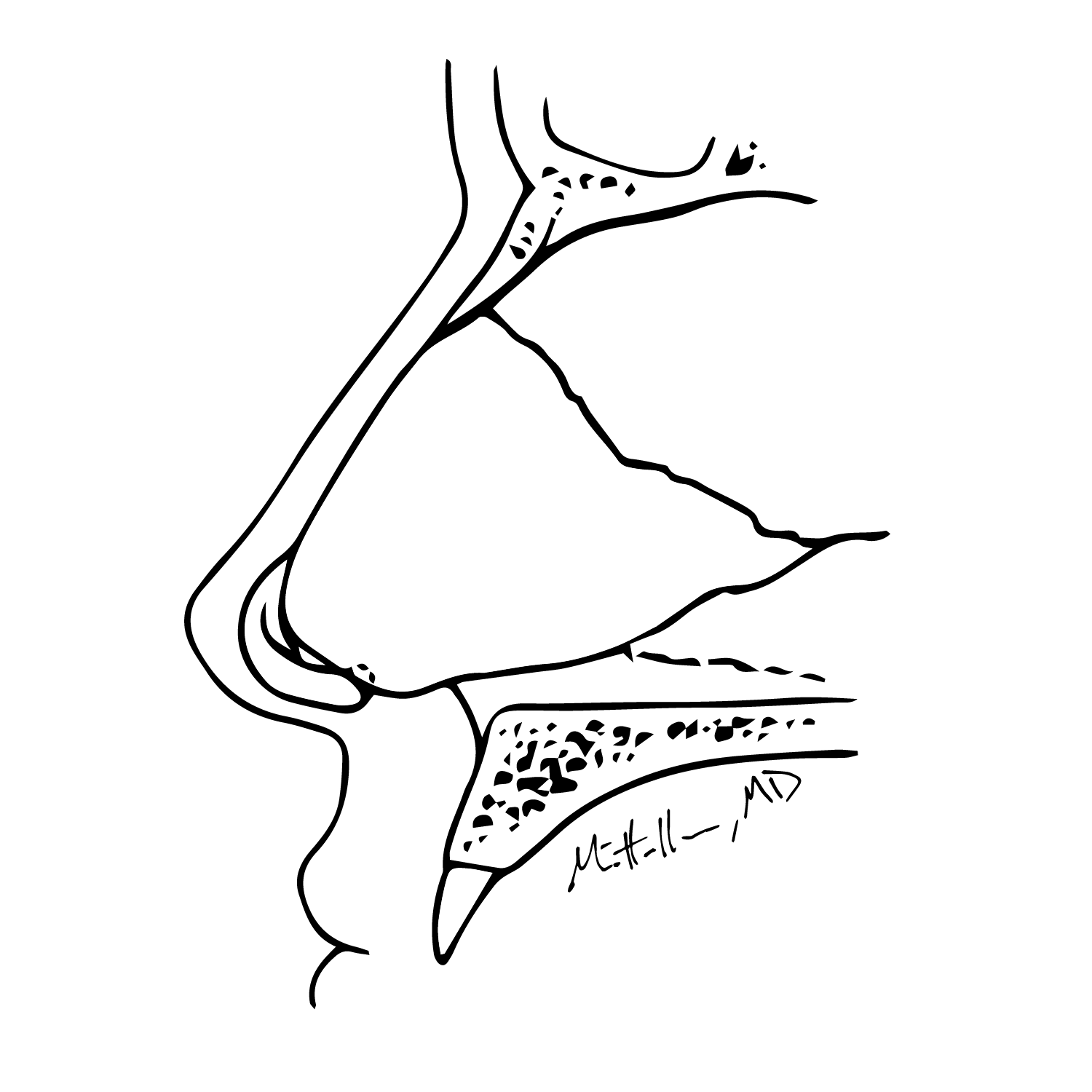
Cartilage grafts for rhinoplasty
Cartilage grafts for rhinoplasty can come from multiple locations, including the septum, ear, rib, or cadavers. Choosing the right one is essential for achieving the desired result from your rhinoplasty.
Which cartilage graft donor site is the best for rhinoplasty?
Septal cartilage
The septum is commonly considered the best site for cartilage grafts in rhinoplasty. It is easily accessible, has an appropriate thickness, and has appropriate strength. It can be harvested from the same site as the rhinoplasty and does not require any additional external incisions.
Oftentimes, septal cartilage is not available for use in rhinoplasty. This commonly occurs in patients who have previously had a septoplasty or in those who have had a prior rhinoplasty. In a secondary rhinoplasty (revision rhinoplasty), it can be essential to have adequate cartilage for perform the proper corrective maneuvers. In those scenarios, locations other than the septum are used for cartilage grafts.


Rib cartilage
Rib cartilage (costal cartilage) is harvested through an incision on the front of the chest. In men, the incision is commonly placed over the desired rib. In women, this incision can be hidden in the crease underneath the breast (inframammary crease). It is usually possible to harvest large amounts of usable cartilage through a small incision. The cartilage can be carved into straight pieces or can be sculpted into small, shaped pieces.
Harvesting rib cartilage does come with additional risks and downsides. One of the risks is introducing air into the chest cavity (pneumothorax). It frequently results in more pain compared to the other sites. It also results in a visible scar on the chest and therefore significant care is taken to use the smallest scar possible for obtaining the required amount of cartilage.


Ear cartilage
Ear cartilage (auricular cartilage) is easily accessible. It requires a separate incision that is often placed on the back surface of the ear. The cartilage acquired from the ear is usually less than what can be acquired from the rib. The cartilage also has a predetermined shape that needs to be adjusted for use in rhinoplasty.


Cadaveric cartilage (Irradiated or Fresh Frozen Cartilage)
Another alternative to autologous cartilage (cartilage taken from one’s own body) is to use cartilage that has been acquired from cadavers and has been appropriately processed and sterilized. The purpose of this graft material is to minimize problems associated with an additional surgical site for harvesting graft material. There have been concerns related to higher rates of absorption, warping, and infection compared to cartilage that comes from the patients themselves.(1-3) This is a relatively new topic however, that continues to have avid proponents.(4)
What costs are associated with cartilage grafts?
If your rhinoplasty is being covered by insurance, there should be no additional costs related to using cartilage from the septum, ear, rib, or cadaver. There are variations in insurance coverage though, and this is evaluated on a case-by-case basis.
What is the recovery like for each of these harvest sites?
Recovery from harvesting septal cartilage is minimal. The recovery will be similar to the recovery expected from your rhinoplasty. There should be no significant increase in pain or duration of downtime.
Ear cartilage harvest does require a separate surgical site, so in addition to the nose, the ear will also be painful. The pain is usually less than that of the rhinoplasty itself. Depending on the amount of cartilage harvested, a small bolster (piece of rolled gauze) will be placed in the ear to provide gentle compression and assist with healing. This is left in place for varied periods of time, but usually no longer than 1 week.
Rib cartilage harvest generally results in the most pain of these options. The muscles of the chest wall attach to the ribs. Manipulating these muscles during the operation will be painful after the operation. This site can also be more painful postoperatively due to movement of the chest wall during normal activities. Attempts are made to minimize pain by limiting the dissection during the operation and by using long-acting anesthetic (numbing) medications.
Cadaveric cartilage use results in no additional pain or recovery time. The recovery will be the same as that seen with a rhinoplasty.
Which donor (septum, rib, ear, cadaver) is the best option?
The best type of cartilage to be used with your rhinoplasty is frequently an individualized discussion. Septal cartilage is commonly the first option. If septal cartilage is unavailable, then ear, rib, or cadaveric cartilage is used. Ear cartilage has a gentler recovery period than rib cartilage, but can sometimes not be ideal for producing the desired effect. Rib cartilage has more risks and a more painful recovery, but is often essential to achieve the desired results. Cadaveric cartilage is becoming more popular, but there continues to be limited long-term, comparative data evaluating this material compared to cartilage that comes from the patient’s own body.
Citations
- Wee JH, Mun SJ, Na WS, Kim H, Park JH, Kim DK, et al. Autologous vs Irradiated Homologous Costal Cartilage as Graft Material in Rhinoplasty. JAMA Facial Plast Surg. 2017;19(3):183-8. Epub 2017/03/24. doi: 10.1001/jamafacial.2016.1776. PubMed PMID: 28334327; PubMed Central PMCID: PMCPMC5540002.
- Rohrich RJ, Shanmugakrishnan RR, Mohan R. Rhinoplasty Refinements: Revision Rhinoplasty Using Fresh Frozen Costal Cartilage Allograft. Plast Reconstr Surg. 2020;145(6):1050e-3e. Epub 2020/05/28. doi: 10.1097/PRS.0000000000006864. PubMed PMID: 32459773.
- Kadakia N, Nguyen C, Motakef S, Hill M, Gupta S. Is Irradiated Homologous Costal Cartilage Reliable? A Meta-Analysis of Complication Rates in Rhinoplasty. Plastic Surgery.0(0):22925503211011973. doi: 10.1177/22925503211011973.
- Mohan R, Shanmuga Krishnan RR, Rohrich RJ. Role of Fresh Frozen Cartilage in Revision Rhinoplasty. Plast Reconstr Surg. 2019;144(3):614-22. Epub 2019/08/29. doi: 10.1097/PRS.0000000000005996. PubMed PMID: 31461014.